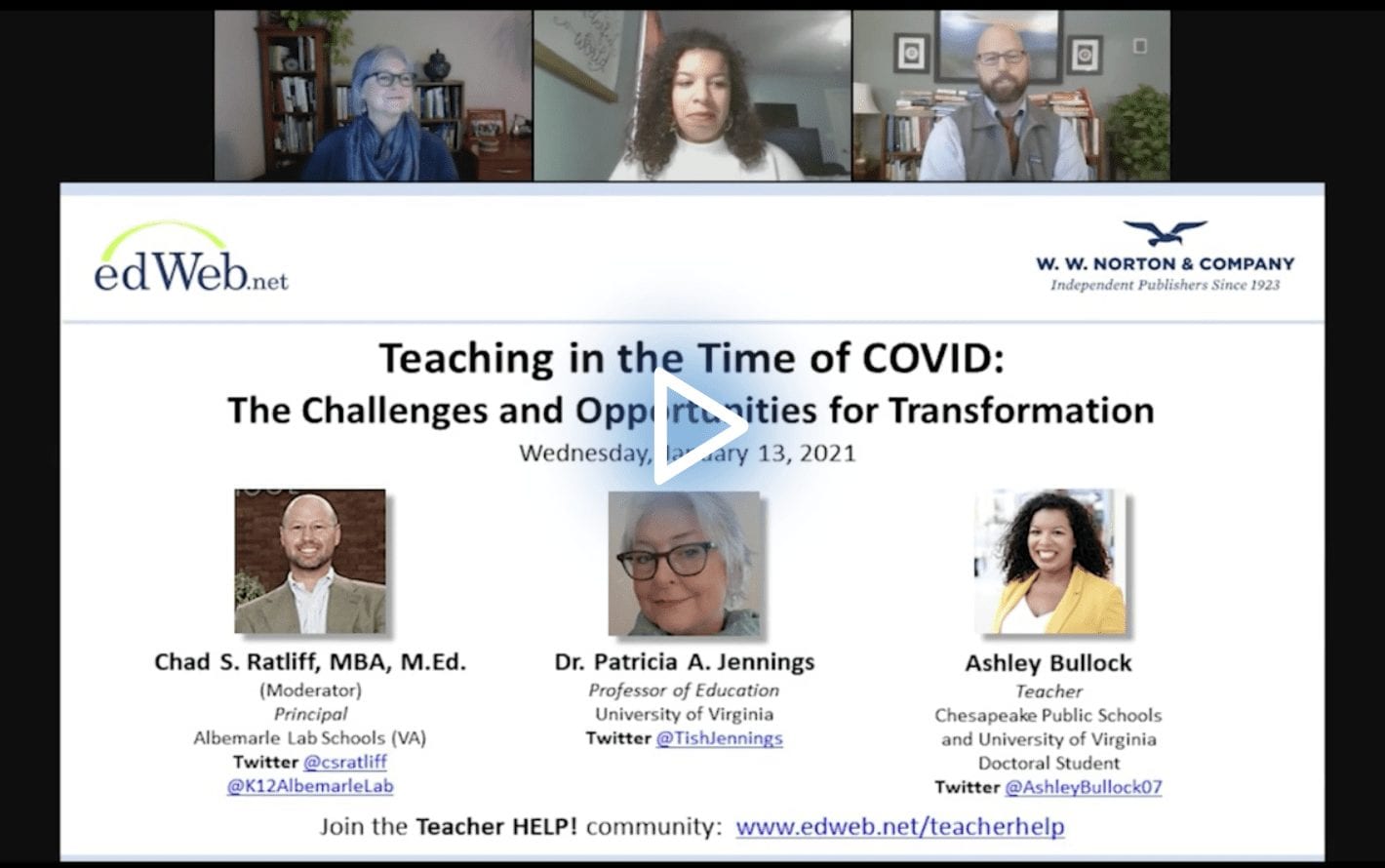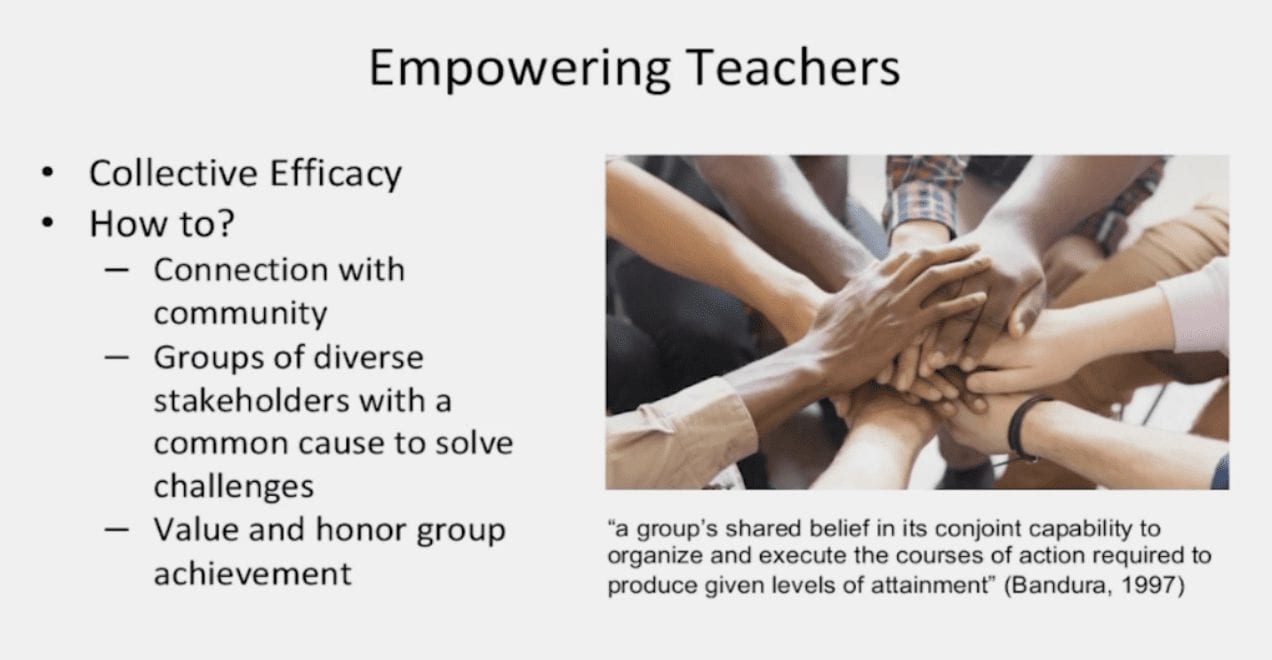Burnout No More: Tips for Managing Teaching Stressors
By Michele Israel
It was one of those days. The bell rang not even halfway through the creative lesson you spent weeks designing. The principal popped in for an impromptu observation. And then Maribel (that Maribel!) tossed balled-up handouts into the trash from the back of the room.
You thought that was hard! Until COVID hit! Your stress has since catapulted, your anxiety mounting each day as you navigate pandemic teaching. You have reached your max and feel like you have lost control.
But it is possible to take charge of stressful situations that disrupt your emotional core. In the recent edWebinar, sponsored by Norton Books in Education, educators and researchers shared how teachers can reduce the impact of stressors to improve the overall work environment, even during difficult times.
Navigating Stressors
Teacher stressors are at every turn: keeping track of students, interacting with parents, responding to administration, and maneuvering a rigid school system. Teaching is a socially, emotionally, and cognitively demanding job, emphasized Dr. Patricia Jennings, Professor of Education at the University of Virginia. The continuous demands exhaust teachers.
“When we’re exhausted,” explained Dr. Jennings, “it’s very hard to maintain our composure when we teach. We may become overly reactive. We might imagine that a student’s behavior is intentional and take it personally. We might feel like we’re running out of time, so we start getting anxious.” Losing composure disrupts the classroom, triggers students, and creates a negative feedback cycle.
COVID has significantly transformed teaching, magnifying stressors, explained Ashley Bullock, a teacher at Chesapeake Public Schools in Virginia. There are new perceptions of teachers, teacher expectations, and teacher/student relationships. There are more top-down approaches and a greater need to balance multiple stakeholders.
Preventing burnout, said Dr. Jennings, involves leveraging demands to improve a school’s working conditions, increasing personal and systemic resources for teachers, and transforming teachers’ work to relieve unrealistic expectations.
Avoid the Unraveling: Strategies for Staying Centered
Teacher struggles are complicated and frequently stressful. But the opportunity for change exists. Putting in place the following strategies can transform teachers’ abilities to navigate complexity and chaos.
Collective efficacy – Teachers and school leaders, said Bullock, are best positioned to engage in systems change at the school level.
Such change can occur through collective efficacy or forming a community of stakeholders to problem solve together, explained Dr. Jennings. Such partnerships tend to influence leadership decisions, lead to change, and drive student success.
Teams can begin by addressing small challenges. Resulting accomplishments build a group’s confidence and competence to take on larger projects—like overhauling a school’s schedule or incorporating unique instructional practices across grades to promote student achievement—that meet community needs.
Student Empowerment – Teachers control how they engage and influence students, explained Chad Ratliff, Principal of Albemarle Lab Schools in Virginia.
Teachers do not have control over decisions a school district makes or COVID data but manage the learning environment. The more agency they have, the more empowered their students are to become creative thinkers and doers.
Regardless of what is happening in the school building, said Ratliff, teachers can teach a lesson, create an assignment, or structure a task that invites students to use their culture, identities, and values to produce diverse and divergent solutions. Removing barriers to learning and discovery is at the heart of this student-centered, culturally responsive teaching.
Take writing an essay. It probably has strict parameters: five paragraphs, double spaced, 12-point font, and it has to be about dogs. It ends up being the teacher’s assignment, not the students’. There’s no room for creativity or navigating concepts from their perspective.
Such constraints not only stymie learning but put the brakes on innovative instruction—a reflection of the systemic rigidity that stresses teachers out. Things like collaboration, interdisciplinary teaching, and authentic learning can alter the educational landscape in this regard.
“When we think about teaching that empowers students and teachers,” emphasized Ratliff, “we should think about community and a groundswell of organic change that comes from you and your colleagues (collective efficacy).”
Intention setting – When stress is at its height, Dr. Jennings recommended teachers revisit the values that made them educators and reinforce the joy and fun they can have doing their jobs.
By envisioning their best selves, teachers can target what they want to address or expand in the classroom while recognizing stressors and how they affect their behavior.
“At one point in my teaching,” shared Dr. Jennings, “I discovered that my tone of voice was causing problems. When I was anxious, my voice would get screechy, and it disrupted the energy in the classroom. So, I sent an intention regularly to notice my voice to calm myself down consciously.”
Intention setting helps teachers realize that they do not have control over everything. It moves them toward transformation as they visualize doing something better. The practice destresses. It gets teachers back on track, allowing them to enjoy their work and recognizing how rewarding it can be.
The next time you feel your blood pressure climbing (and when Maribel plays trash-can basketball again), take a deep breath. Remember why you teach and partner with others to effect even a small change. Strive for empowerment that frees you from stress-rich practices.
This edWeb broadcast was sponsored by Norton Books in Education.
About the Presenters
Dr. Patricia (Tish) Jennings is a professor of education at the University of Virginia and an internationally recognized leader in the fields of social and emotional learning and mindfulness in education. Her research places a specific emphasis on teacher stress and how it impacts the social and emotional context of the classroom. Dr. Jennings recently led the team that developed CARE, a mindfulness-based professional development program shown to significantly improve teacher well-being, classroom interactions and student engagement in the largest randomized controlled trial of a mindfulness-based intervention designed specifically to address teacher occupational stress. She is the editor of Norton Books in Education’s Social and Emotional Learning Solutions series and the author of the best-selling Mindfulness for Teachers, Mindfulness in the Pre-K – 5 Classroom, The Trauma-Sensitive Classroom, and Teacher Burnout Turnaround.
Ashley Bullock is a teacher at Chesapeake Public Schools (VA), and a doctoral student at the University of Virginia. She jokes that she is a slightly together, slightly a mess educator who is trying to find the best practices to support all her students. Having worked in diverse schools, she firmly believes that supporting teachers and empowering students is the best way to change the world for the better. Her passions include educational topics such as equity in education, trauma-informed practices and vicarious trauma to teachers. In her off time, you can find her at the beach, traveling, watching sports, and eating really good pizza.
About the Moderator
Chad Ratliff has been Principal of Murray High School and Community Public Charter School (Community Middle) in Virginia since 2017, previously serving as Director of Innovation and Instructional Programs for Albemarle County Public Schools. He is also a teacher in the upper school, facilitating a dual enrollment course in entrepreneurship and the theory of knowledge course in the school’s International Baccalaureate (IB) Diploma Program. Chad is co-author of Timeless Learning: How Imagination, Observation, and Zero-Based Thinking Change Schools (Jossey-Bass, 2018). He also authored the foreword, “On Liberating Teachers,” in University of Virginia Professor Dr. Patricia Jennings’ book, Teacher Burnout Turnaround: Strategies for Empowered Educators (Norton, 2020). In 2017, the National School Boards Association named him one of the “20 to Watch” educational leaders in the country.
Join the Community
Teacher HELP! is a free professional learning community on edWeb.net that helps teachers get advice, support, and share experiences about teaching.
Norton Books in Education publishes breakthrough professional development books for K-12 teachers and administrators from leading voices in the field.
Michele Israel writes about the ideas and best practices shared in edWeb’s edWebinars to spread innovative and best practices to the education community. Michele owns Michele Israel Consulting, LLC, which serves large and small educational, nonprofit, media, corporate, eLearning, and blended-learning organizations to bolster products and programs. Her rich career spans over 25 years of successfully developing educational materials and resources, designing and facilitating training, generating communication materials and grant proposals, and assisting in organizational and program development. In addition to lesson plans and other teacher resources, Michele’s portfolio includes published articles covering various educational and business topics.






Comments are closed.